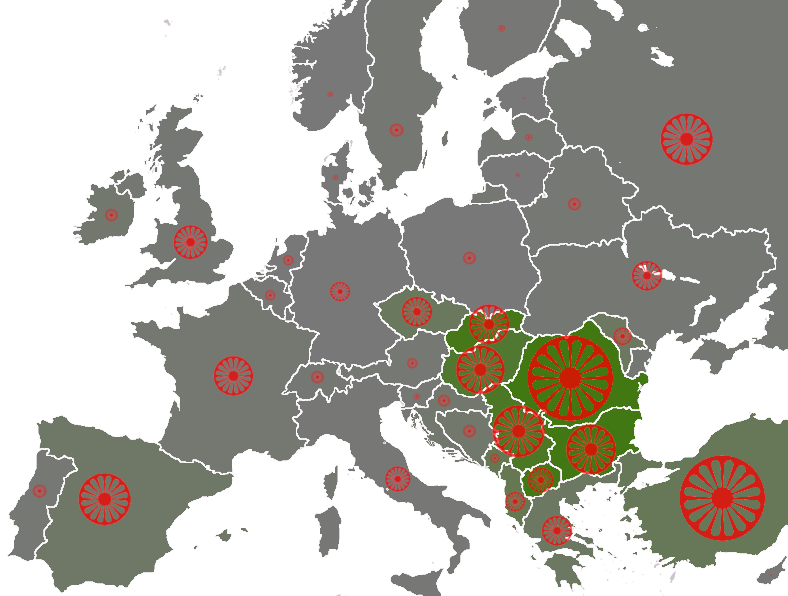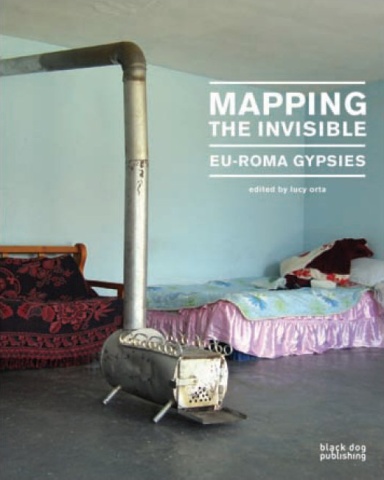Of course both terms here are used in a wider sense than the currently trending meanings. Already for this one is very grateful. 'Mapping' has become a dead term, suffocated by start up app developers and run over by cross-discipline geographers. In the context of this publication additional potential of mapping breathes some live back into a dead corps with a lot of success and in fact very few maps.
Before even talking about any content, the main element of the book are the photographs. This probably wan't intentional and the photographs are neither glossy nor very good, but they tell the story, illustrate factual and narrate emotionally. There are currently very few publications out there that manage a similar intensity using photographs.

Image taken from Wikipedia / populations of the Romani people by country, showing the "average estimate" published by the Council of Europe[1]. Based on these estimates are the number of seats by country in the European Roma and Travellers Forum (ERTF) based in Strasbourg. The size of the wheel symbol represents total population by country (Romania 1.85 million), the shade of each country's background colour represents the percentage of Romani with respect to the total population (Romania 8.5%). The three different green shadings 0%, 5%, 10%
The current state of the Gypsies is documented in five chapters as 'History Migration', 'Human Rights', 'Extreme Poverty', 'Creative Ingenuity' and 'Family Identity'. These topics are simultaneously observed in different European countries, such as Italy, England, Romania, Turkey or Greece. Interestingly each topic is portrait in a spatial context and even though the cuture is largely known as traveling or travelers, the place, here used distinct from space, is always very important. This provides sort of a continuous tread through out the book and continuously pieces start interlocking. However, there is no need to read linearly, thanks to this thread.
What are Gypsies? Wikipedia says this: "The Romani (also Romany, Romanies, Romanis, Roma or Roms; exonym: Gypsy; Romani: Romane or Rromane, depending on the dialect) are an ethnic group living mostly in Europe, who trace their origins to the Indian Subcontinent.
The Romani are widely dispersed, with their largest concentrated populations in Europe, especially the Roma of Central and Eastern Europe and Anatolia, followed by the Iberian Kale in Southwestern Europe and Southern France. Deported to Brazil by Portugal during the colonial era [16] and via more recent migrations, some people have gone to the Americas and, to a lesser extent, other parts of the world."
The book's effort is summarised in the foreword by Alexander Valntino and Lucy Orta as: "European Roma mapping stemmed fromt he need to know more about the precarious living conditions of the Romani across Europe. Awareness, we believe is an absolut necessary first step towards an auspicious change in the Roma condition." And this is definitely what the term invisible describes, a cultural group disappearing in the in the sea of sub suburb sprawl of individualised housing and generalised industry.
Clearly the Roma people are marginalised and pushed to the edge of society. Hoever, every now and then the Roma culture has played a role in a broader cultural movement as for example in links to the Situationist, who were especially interested in the idea of moving. More recently in 2007 the first Roma pavilion at the 52nd Venice Biennale was established as discussed with Daniel Baker in the chapter 'Creative Ingenuity'.

Taken from Valentina Schicardi / A photograph taken from the series on the Holy Communion of the granddaughter.
The book manages to produce a comprehensive documentation, aso for a lay audience, of the Roma culture and the current state of place it is manifesting itself. This is clearly a very sad situation and in all the different countries an unsolved condition without any ideas or concepts in reach for improvement.
This documentation is on the other hand also a clear reflection and the society we live in and how this society we are al part of treats certain groups. You thought slums are something that only exists in faraway, exotic countries, think again. Talking about the latest flashy architecture magazine glossi spread? Read this publication and you'll learn a lot more about what architecture could mean and the role it would play.
This publication is low key and at first glance resembles more a comprehensive study report or a sophisticated thesis. However, this is extremely misleading flipping through will unveil the density and comprehensiveness of the documentation and the liveliness of the images will bring you goos bumps
into your cosy living room. There might be no over designed layout, but the power of the narrative here are simply incredible. A must have for every analytically interested architect as well as all the mapper out there. A wakeup call for the urbanised, western societies for a lot more than the subject at hand. A very important contribution, especially now in this conservatives' dominated political and social climate.
Also read a review of the book at we-make-money-not-art.

Image taken from Radio.CZ / Publication cover.
Orta, L., 2010. Mapping the Invisible: EU-Roma Gypsies, Black Dog Publishing Ltd.
Tidak ada komentar:
Posting Komentar